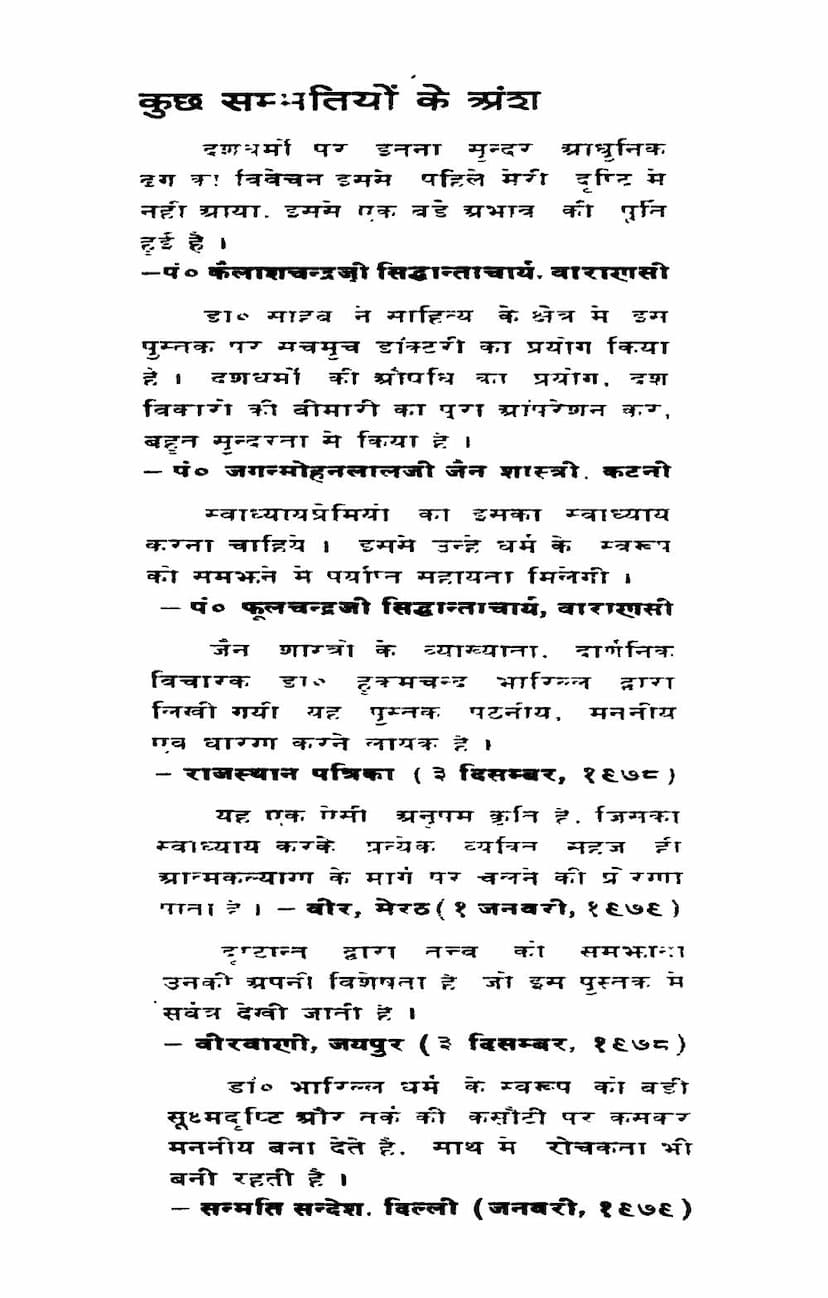Dharm Ke Dash Lakshan
Added to library: September 1, 2025

Summary
Here's a comprehensive summary of the Jain text "Dharm ke Dash Lakshan" (The Ten Characteristics of Dharma) by Hukamchand Bharilla, based on the provided pages:
Overview and Purpose:
"Dharm ke Dash Lakshan" is a profound and popular work by Dr. Hukamchand Bharilla, published by Todarmal Granthamala, Jaipur. The book delves into the ten essential virtues (Dash Lakshan) central to Jainism, which are celebrated annually in the Dshalakshan festival. The author, a respected scholar and spiritual proponent influenced by Pujya Shri Kanji Swami, aims to present these virtues in a modern, accessible, and deeply spiritual manner. The book has seen multiple successful printings, indicating its wide appeal and impact.
The Ten Virtues (Dash Lakshan):
The core of the book revolves around the detailed exposition of the ten virtues, which are not mere rituals but profound spiritual principles that lead to self-realization and liberation. These are:
- Uttam Kshama (Supreme Forgiveness): Defined as the natural state of the soul, free from anger. It involves overlooking faults and not harboring resentment. The text emphasizes that true forgiveness is not about enduring mistreatment but about the absence of anger within oneself.
- Uttam Mardav (Supreme Humility): The absence of pride or ego. It's about recognizing the inherent equality of all souls and shedding the arrogance of considering oneself superior. The book contrasts true humility with false displays of meekness.
- Uttam Prajval (Supreme Straightforwardness/Honesty): The absence of deceit or crookedness. It signifies speaking and acting with sincerity and transparency, aligning one's thoughts, words, and actions.
- Uttam Shaucha (Supreme Purity/Contentment): The absence of greed or avarice. It involves being content with what one has and not being driven by acquisitiveness. The text highlights that true purity comes from within, not from external cleanliness.
- Uttam Satya (Supreme Truth): Speaking the truth, but more importantly, living truthfully. It's about aligning one's actions with one's understanding of reality and not deviating from one's true nature.
- Uttam Samyam (Supreme Restraint): Control over the senses and mind. This involves regulating desires and actions to prevent harm to oneself and others.
- Uttam Tapa (Supreme Austerity): Voluntary hardship undertaken for spiritual purification. It's not about self-punishment but about diligent effort in spiritual practices to burn away karmic impurities.
- Uttam Tyag (Supreme Renunciation): Giving up attachments to possessions and desires. This can range from material renunciation to the relinquishment of inner attachments like pride or anger.
- Uttam Akinchanya (Supreme Non-possession): The absence of attachment to anything, including one's own body and mind. It signifies a state of complete detachment from external and internal possessions.
- Uttam Brahmacharya (Supreme Celibacy/Chastity): This encompasses not only physical chastity but also the control of all senses and the mind, redirecting all energy towards the soul. It's about abiding in one's true self, the pure soul.
Key Themes and Insights:
- Universality and Timelessness: The Dshalakshan festival and the virtues themselves are presented as universal and eternal, not tied to specific events or individuals. Their importance lies in their connection to the soul's inherent qualities and their ability to bring happiness and alleviate suffering for all beings.
- Inner Purity over Outer Ritual: While external practices are acknowledged, the book strongly emphasizes the internal aspect of these virtues. True forgiveness is the absence of anger, true purity is internal contentment, and true restraint is the mastery of the inner self.
- The Role of "Uttam" (Supreme): The prefix "Uttam" before each virtue signifies that these are not mere ordinary qualities but the highest, purest form of these virtues, achievable only through right faith (Samyak Darshan) and right knowledge (Samyak Gyan). They are the natural expressions of an enlightened soul.
- Practical Application and Psychological Analysis: Dr. Bharilla uses modern language, psychological insights, and relatable examples to explain these ancient principles. He analyzes common misconceptions and the practical challenges in embodying these virtues in daily life.
- The "Why" Behind the Virtues: The book explains that these virtues are not arbitrary rules but are rooted in the consequences of actions. They are the means to overcome vices (vikars) like anger, pride, deceit, and greed, which are the sources of suffering.
- Critique of Superficial Observance: The author critiques the superficial observance of these virtues, particularly in the context of festivals like Kshama Vani (Day of Forgiveness). He laments the mechanical and insincere way in which people often engage in these practices, highlighting the disconnect between outward actions and inner conviction.
- The Importance of Self-Realization: Ultimately, the cultivation of these ten virtues is presented as a path towards realizing the true nature of the soul and attaining liberation. The focus is on internal transformation rather than mere external adherence.
- Influence of Spiritual Lineage: The author's work is deeply influenced by the spiritual teachings of Pujya Shri Kanji Swami, emphasizing a profound, introspective approach to Jain philosophy.
Structure and Style:
The book is structured to provide a comprehensive understanding of each of the ten virtues, followed by a chapter on Kshama Vani (the day of seeking and granting forgiveness). The language is described as simple, clear, and profound, making complex philosophical concepts accessible to a wide audience. The author's style is praised for its analytical depth, inclusion of relatable examples, and the ability to engage the reader.
In essence, "Dharm ke Dash Lakshan" serves as a guide to understanding and practicing the ten core virtues of Jainism, not as rigid rules, but as a path to inner transformation, self-realization, and ultimate happiness.